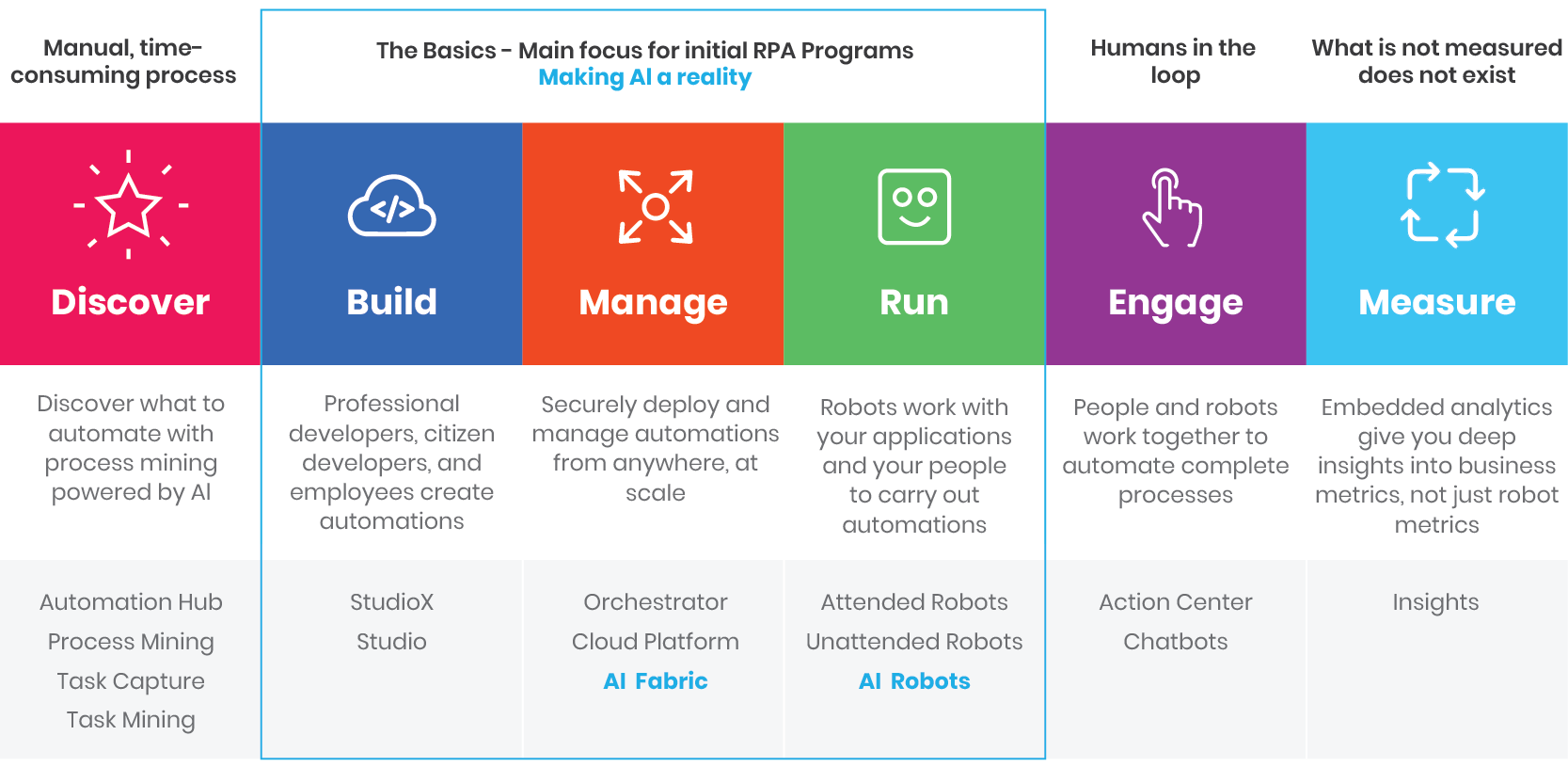In the last 12 months, the process automation space has gone through a significant transformation. Leading RPA platforms like UiPath have further integrated with key technologies to bring to market actionable solutions that enable companies to achieve even higher levels of end-to-end automation and reach “Hyperautomation,” using a term originally coined by Gartner.
We like to define Hyperautomation as the integration of RPA with other technologies such as Process Mining, Predictive Analytics, Machine Learning, and Digital Workforce Integration with Humans. In 2020, such an offering became integral for key automation players in the industry to provide the latest solutions and help their clients modernize and adapt to the constant changes happening in the marketplace.
These key technologies include:

UiPath: The Only Platform Built to Support the Full Automation Lifecycle
This year, Auxis accomplished a very important milestone: achieving the highest level of certification (USN) for professional services partners of UiPath.
As part of our strong partnership, we have experienced firsthand the latest advancements in their platform – which has evolved to be the only RPA platform in the market built to support the full automation lifecycle from discovery to measurement:

Some key UiPath enhancements that took place this year and that our clients are starting to benefit from include:
1. Long Running Workflows:
For the longest time, automation has been seen as a technology that is expected to work on its own from start to finish without the interaction of humans. This all sounds great, but in real life, multiple processes cannot be 100% automated for the simple reason that approvals are required or inputs are needed during the process. This has left out a significant number of potential processes because of the added complexity.
For this reason, UiPath created a platform that enables interaction and collaboration between digital and human workforces, opening the door for many more automations in a cost-effective and actionable manner. Robots can now ask questions or inputs to team members, continuing with other tasks while waiting for the response and then returning to the initial task once an answer has been provided.
2. Machine Learning and Predictive Analytics:
One of the hardest things to identify and implement is the use of machine learning (ML) models for two key reasons. One is that, by definition, predictive analytics stands on the premise that past behavior can predict future outcomes. With major changes such as the ones we have experienced this year with COVID, most ML models have been rendered useless as most business patterns have changed or shifted. The second is that it is very expensive to build and maintain these models, requiring very costly and hard-to-find resources such as data scientists and advanced developers.
For these reasons, UiPath built out-of-the-box, drag-and-drop ML models that can be consumed by all organizational sizes, and that can be customized and fixed much quicker than traditional in-house development. This has enabled us to bring amazing solutions to our customers at a fraction of the cost, democratizing the power of ML.
3. Native/API Integration:
In the last 12 months, automation has been simplified by the ongoing trend of exposed APIs and integrations by all major applications. Before 2020, many application companies did not expose API or Integrations in order to keep customers captive to their solution, making it harder for them to adopt other technologies.
Hyperautomation has forced companies to offer integrations in order to be considered as a viable future-looking solution. This has allowed UiPath and its implementation partners to bring faster and simpler automations to their clients that are more stable and easier to implement and maintain.
4. Process Document Understanding:
UiPath Document Understanding combines robotic process automation (RPA) and artificial intelligence (AI) to help organizations extract and interpret data from different documents (e.g., AP invoices, loan applications, employee applications, etc.) and ensure end-to-end document processing. The tool works with a wide range of documents from structured to unstructured, recognizes different objects like tables, handwriting, signatures, or checkboxes, and can deal with various file formats.
Before the release of Document Understanding, we at Auxis had been working very successfully with a similar IA Data Capture tool called Ephesoft that also connects seamlessly to UiPath.
Both Document Understanding and Ephesoft are great solutions to capture unstructured data from any type of document and source, and effectively classify, index, and extract key metadata to deliver this data automatically to an organization’s ERP, CRM, RPA, and other applications. In order to choose the best alternative for your company, key evaluation criteria may include your volumes of images processed per year and your budget and expected ROI.
Stay tuned for more advancements in the UiPath platform and overall RPA industry. According to a September 2020 Gartner report, global RPA software revenue is projected to reach $1.89 billion in 2021, with a 19.5% increase from 2020.
RPA is here to stay with its global market share forecasted to continue to grow by double digits through 2024. Businesses not adopting a competitive automation strategy will soon be


